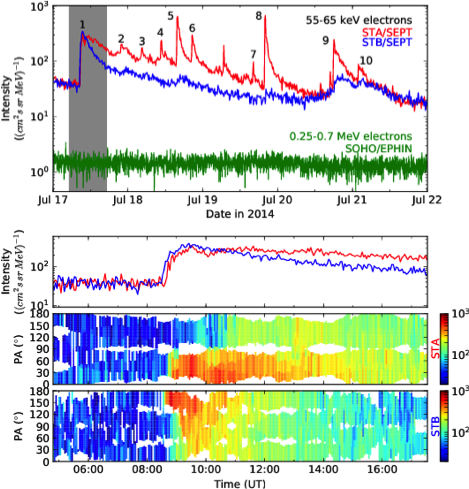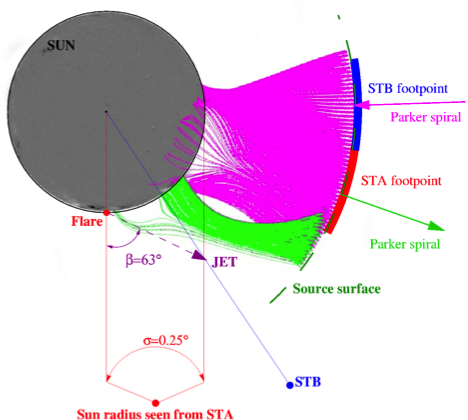STEREO and near-Earth multi-spacecraft observations of solar energetic particle (SEP) events have revealed that some events show quite unexpected intensity distributions at 1 AU (Dresing et al. 2012, Lario et al. 2013). They can be much broader (circumsolar) (Gómez-Herrero et al. 2015), non-symmetric, and sometimes irregular showing so-called finger distribution (Klassen et al. 2016). It had been suggested that these non-symmetric and irregular distributions, among others, may result from non-radial particle injection and propagation in the solar corona below the solar wind source surface.
In this nugget we present an SEP event which indeed shows a clear evidence for such strongly non-radial electron injection and propagation in the solar corona. The detected electron event was associated with a giant coronal jet observed in extreme ultraviolet (EUV) appearing at the border of an isolated equatorial coronal hole (CH). At that time the angular separation between the flare and magnetic footpoints connecting the Sun to STA and STB was 68° and 90°, respectively.
Observation
Fig. 1 presents a series of 13, mostly impulsive electron events detected by the Solar Electron and Proton Telescope (SEPT) at STEREO-A (STA, red) and STEREO-B (STB, blue) between 17 and 22 July 2014.
 Figure 1. Overview of electron time profiles measured at STA (red), STB (blue) and SOHO (green) during 17–21 July 2014. Top: sequence of numbered electron events originated from the same AR. Only the first event was detected at both STEREO s/c. Bottom: enlarged time profiles and intensity pitch-angle (PA) distributions of the first event (shaded interval on the top). Both s/c detected anisotropic PA distributions, similar time profiles and peak intensities with an earlier onset at STB.
Figure 1. Overview of electron time profiles measured at STA (red), STB (blue) and SOHO (green) during 17–21 July 2014. Top: sequence of numbered electron events originated from the same AR. Only the first event was detected at both STEREO s/c. Bottom: enlarged time profiles and intensity pitch-angle (PA) distributions of the first event (shaded interval on the top). Both s/c detected anisotropic PA distributions, similar time profiles and peak intensities with an earlier onset at STB.
Only the first event was detected by both STEREO s/c, which showed very similar impulsive time profiles and comparable peak intensities. Ten of the 13 events numbered in Fig. 1, were associated with recurrent flares and EUV-jet activity in the same small AR located at the border of an isolated equatorial CH (Fig. 2 left). Looking at Fig. 2 left only, it is hard to understand how the electrons managed to arrive at the s/c footpoints, taking into account that the separation angles between the flare and s/c were 68° and 90° for STA and STB, respectively. But the view at the right two images provides an idea how it was possible. A very long , >= 1Rsun, EUV jet associated with a small flare, type III radio bursts and SEPs shows the possibly very inclined trajectory of electrons from the flare site to the s/c. Using the simultaneous STA and STB stereoscopic observations, we estimated the inclination angle of the EUV jet as 63° (see Fig. 3).

Figure 2. Left: STB direct EUV image showing the coronal hole (CH), flare position and magnetic footpoints connecting the Sun to STA & STB. Middle & Right: STB and STA, respectively. Seven step difference images (304 A) showing the giant jet propagating from the central meridian to the west limb as viewed from STA. The arrows indicate the flare location and the ellipses show the nominal magnetic footpoints ±10°.
Previous jet imaging observations and modeling have shown that the jet material should be ejected and transported along open magnetic field lines. The associated type III electrons should propagate along the same trajectory as the jet. Additionally the observation of near-relativistic electrons in-situ at 1 AU requires that the large-scale coronal magnetic field should be also open to interplanetary space.
To support these facts we derive the distribution of open coronal magnetic field lines in the vicinity of both s/c footpoints using Potential Field Source Surface (PFSS) extrapolation. The PFSS analysis (Fig. 3) shows that indeed a few of the magnetic field lines originating close to the flare and CH border were connected to the vicinity of the STA footpoint at the source surface. The jet trajectory itself traces this magnetic field, showing evidently its extended and inclined configuration. It should be noted that the flare was located at the solar backside and out of the most reliable window with “fresh” magnetograph data. Nevertheless, we found that also during the long period – between 7 and 25 July – the magnetic configuration was quite stable with non-radial field lines extending far westward from the AR, like in Fig. 3.
 Figure 3. Jet trajectory reconstruction in the ecliptic plane using the stereoscopic EUVI 304 Å observations from both STEREO points of view. The jet trajectory is overplotted by PFSS open magnetic field lines. The reconstruction yields a strongly non-radial jet trajectory from the flare site toward the magnetic footpoints of both s/c with an estimated inclination angle of β = 63° relative to the radial direction. The magnetic fields correspond to positive (green, outward arrow) and negative polarities (pink, inward arrow).
Figure 3. Jet trajectory reconstruction in the ecliptic plane using the stereoscopic EUVI 304 Å observations from both STEREO points of view. The jet trajectory is overplotted by PFSS open magnetic field lines. The reconstruction yields a strongly non-radial jet trajectory from the flare site toward the magnetic footpoints of both s/c with an estimated inclination angle of β = 63° relative to the radial direction. The magnetic fields correspond to positive (green, outward arrow) and negative polarities (pink, inward arrow).
Conclusion
The presented observations provide evidence of a strong non-radial propagation of near-relativistic electrons in the solar corona below the source surface, during the SEP event on 17 July 2014. The event was associated with a small flare occurring at the border of an isolated CH and a very long EUV jet which propagated from the flare site toward the magnetic footpoints of both s/c, along a strongly inclined trajectory (63°) relative to the radial direction.
The energetic electrons propagate along the same path as the observed EUV jet and were detected at both STEREO s/c, despite the large angular separation of 68° and 90° between the flare and the estimated magnetic footpoints of STA and STB, respectively. Despite this large separation, one of the widest reported for impulsive SEPs so far, both s/c detected a similar impulsive electron event, suggesting an optimal connection to the parent particle source.
This illustrates very well that the accuracy of ballistic backmapping is sometimes not sufficient to characterize the magnetic connectivity of the s/c to the Sun during SEP events. The main deviation from the nominal magnetic connectivity occurs evidently below the source surface. We have shown how the electrons, accelerated during a small flare and jet activity, propagate along strongly non-radial magnetic fields below the source surface and reach very distant longitudes in the heliosphere, when the flare was not nominally connected to the s/c.
Based on the recent paper: A. Klassen, N. Dresing, R. Gómez-Herrero, B. Heber, and A. Veronig (2018). Strong non-radial propagation of energetic electrons in solar corona. A&A 614, A61, https://doi.org/10.1051/0004-6361/201732041
References
Dresing, N., Gómez-Herrero, R., Klassen, A., et al. 2012, Sol. Phys., 281, 281
Gómez-Herrero, R., Dresing, N., Klassen, A., et al. 2015, ApJ, 799, 55
Klassen, A., Dresing, N., Gómez-Herrero, R., Heber, B., & Müller-Mellin, R. 2016, A&A, 593, A31
Lario, D., Aran, A., Gómez-Herrero, R., et al. 2013, ApJ, 767, 41
